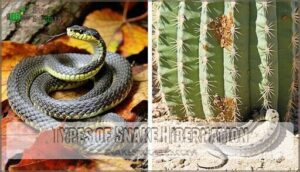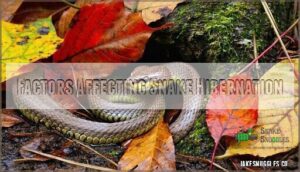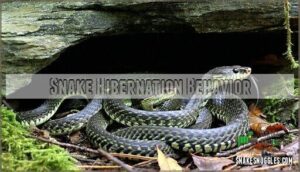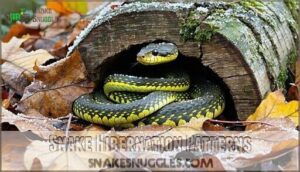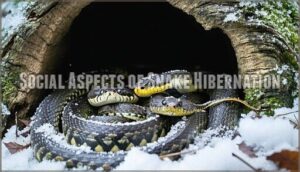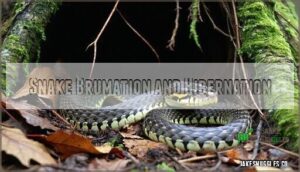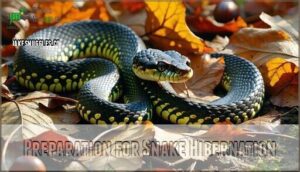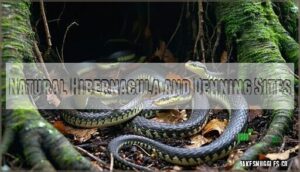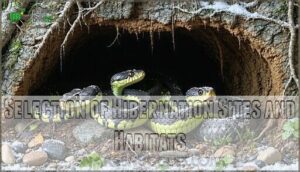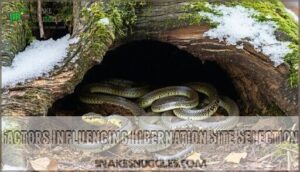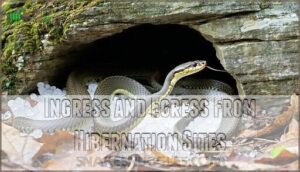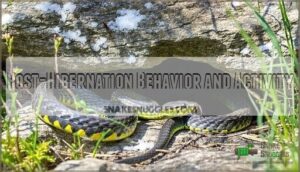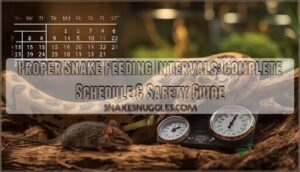This site is supported by our readers. We may earn a commission, at no cost to you, if you purchase through links.

You’ll find them slowing their metabolism to nearly a standstill while their body temperature drops to match their chilly surroundings.
They’ll seek out underground dens, rock crevices, or burrows where they remain mostly motionless for three to eight months, and some species gather in writhing masses of hundreds, while others prefer going solo.
This clever survival trick lets them conserve energy when prey’s scarce and temperatures plummet, revealing nature’s most ingenious energy-saving strategies that are crucial for their winter survival.
Table Of Contents
- Key Takeaways
- Snake Hibernation Process
- Types of Snake Hibernation
- Factors Affecting Snake Hibernation
- Snake Hibernation Behavior
- Snake Hibernation Patterns
- Social Aspects of Snake Hibernation
- Snake Brumation and Hibernation
- Preparation for Snake Hibernation
- Snake Hibernation Sites and Habitats
- Emerging From Snake Hibernation
- Frequently Asked Questions (FAQs)
- For how long do snakes hibernate?
- Why do snakes hibernate in winter?
- What happens if a snake hibernates?
- How do snakes prepare for hibernation?
- Do snakes hibernate in houses?
- Does a snake hibernate if temperatures are low?
- What do snakes do when they hibernate?
- How do snakes survive winter in Canada?
- What is snake hibernation?
- Do snakes hibernate in the summer?
- Conclusion
Key Takeaways
- You’ll discover that snakes don’t truly hibernate like mammals – they enter brumation, a reptile-specific dormant state where they remain semi-conscious and can occasionally wake during warm spells to drink water or adjust their position.
- You’ll find that snakes dramatically slow their metabolism by up to 90% during brumation, reducing their heart rate, breathing, and body temperature to match their surroundings while relying entirely on stored fat reserves for survival.
- You’ll see snakes seeking underground dens, rock crevices, or burrows below the frost line for 3-8 months, with some species gathering in communal hibernacula of hundreds while others prefer solitary winter retreats.
- You’ll notice that climate change and geographic location significantly impact hibernation patterns – northern snakes brumate longer than southern species, while rising temperatures cause earlier emergences and disrupt traditional breeding cycles.
Snake Hibernation Process
When winter arrives, you’ll find snakes undergoing remarkable physiological transformations that allow them to survive months without food or regular activity.
These changes include dramatic drops in metabolism, heart rate, and breathing patterns while their bodies rely entirely on stored fat reserves for energy.
Physiological Changes During Hibernation
Winter transforms snakes into masters of energy conservation through remarkable physiological changes.
Their metabolic rate plummets dramatically, allowing torpor survival during harsh months when prey becomes scarce.
- Heart rate drops substantially – reducing oxygen needs and conserving essential energy reserves
- Body temperature regulation shifts – snakes rely entirely on external heat sources for warmth
- Metabolic slowdown occurs – snake physiology adapts to minimal energy expenditure during dormancy
Metabolic, Hormonal, and Temperature Changes
When snakes settle in for winter, their bodies undergo remarkable metabolic slowdown.
Their metabolic rate drops dramatically—sometimes by 90%—while hormonal shifts suppress reproductive functions.
Temperature regulation becomes passive, matching surroundings perfectly.
Breathing changes reduce oxygen needs substantially.
This coordinated energy conservation lets them survive months without food.
Garter snakes exhibit substantial intestinal down-regulation during hibernation to conserve energy.
| System | Change | Benefit |
|---|---|---|
| Metabolism | 90% reduction | Energy conservation |
| Hormones | Sex hormone suppression | Resource redirection |
| Temperature | Matches environment | Minimal energy use |
Vernalization and Reproductive Hormones
During winter’s grip, your snake’s body performs amazing hormonal adjustments that prepare for spring romance.
Vernalization triggers critical changes in reproductive hormone production, particularly boosting estrogen-making genes when temperatures rise. This snake hibernation process guarantees perfect reproduction timing – females develop pheromones while males prepare testosterone systems.
These hormonal triggers create an evolutionary advantage, synchronizing breeding with ideal conditions. The vernalization effects mean emerging snakes are hormonally primed for successful snake reproduction, maximizing survival through precise climate impact responses.
Fluctuations in testosterone levels are also observed during these cycles.
Body Temperature Regulation and Breathing Habits
During metabolic slowdown, you’ll find snakes become thermal-regulation masters. Their breathing rate drops dramatically, allowing freezing tolerance while maintaining essential body temperature above lethal thresholds.
Thermoregulation strategies include:
- Den sharing creates thermal gradients for warmth
- Breathing shifts to minimal oxygen consumption
- Body temperature stabilizes near freezing point
- Cutaneous respiration supplements reduced lung function
- Underground positioning maximizes temperature regulation
Energy Conservation and Fat Reserves
You’ll witness nature’s ultimate energy-efficiency plan during snake energy conservation methods. Before winter hits, pre-hibernation feeding builds vital fat reserves through energy storage optimization.
During brumation, metabolic slowdown dramatically reduces their metabolic rate reduction, preventing fat reserve depletion.
This strategic snake metabolism adjustment guarantees successful post-hibernation recovery when spring arrives.
Types of Snake Hibernation
You’ll encounter several distinct types of snake dormancy, each adapted to specific environmental challenges.
From true hibernation in frigid climates to aestivation in scorching deserts, snakes have evolved remarkable strategies to survive when conditions become too harsh for normal activity.
True Hibernation in Cold Regions
When winter hits hard, you’ll find snakes battening down in hibernacula – underground dens, rock crevices, or basements.
These coldblooded animals experience a dramatic metabolic slowdown during deep freeze conditions.
Group denning becomes their survival strategy, with hundreds sharing warmth in communal snake hibernation sites.
Regional variations affect timing, but winter survival depends on proper snake survival shelter selection.
Aestivation in Hot and Arid Environments
During scorching summer months, desert snakes cleverly employ aestivation—their own version of snake dormancy—to survive brutal heat.
When temperatures soar above 110°F, these reptiles showcase remarkable Desert Adaptations and environmental factors response:
- Shade Seeking: They retreat to rocky crevices, burrows, or dense vegetation for thermal protection
- Water Conservation: Metabolic Shifts reduce bodily functions, minimizing moisture loss through respiration
- Activity Patterns: They remain motionless during peak heat, emerging only during cooler nighttime hours
This reduced activity strategy helps snakes endure extreme drought conditions for weeks.
Denning in Groups and Solitary Denning
When snakes choose their winter homes, you’ll find fascinating differences between group hibernation and solitary hibernation.
Communal dens offer group thermoregulation, where dozens or even thousands of snakes share body heat through den sharing.
Species mixing creates incredible diversity in these denning sites.
However, solitary safety appeals to independent snakes who avoid hibernacula competition and select private den sites for maximum control over their survival conditions.
Brumation and Its Characteristics
While group denning offers warmth through shared heat, brumation reveals reptile behavior’s fascinating adaptations.
Unlike mammalian hibernation, snake hibernation involves semi-consciousness with occasional wakeful periods.
During reptile brumation, you’ll observe reduced activity and metabolic slowdown as snakes enter temperature reliance mode.
Their bodies maintain limited movement while conserving energy through winter’s harsh conditions.
Snakes prepare through gradual dietary changes to facilitate proper digestion shutdown.
Key brumation characteristics include:
- Metabolic slowdown reduces energy needs by up to 70%
- Semi-consciousness allows periodic drinking and waste elimination
- Temperature reliance on external heat sources for survival
- Reduced activity with minimal movement for months
- Limited movement helps preserve vital fat reserves
Factors Affecting Snake Hibernation
You can’t predict when a snake will hibernate without understanding the key factors that drive this behavior.
Food availability, temperature changes, geographic location, and seasonal shifts all work together to determine when snakes enter brumation and how long they’ll stay dormant.
Food Availability and Prey Abundance
Think of winter’s buffet shutting down completely.
When food availability plummets, snakes can’t hunt their usual prey.
Prey scarcity forces them into longer hibernation periods, burning through precious fat reserves they’ve stored.
These energy stockpiles determine survival odds during snake hibernation.
Well-fed snakes entering winter with robust reserves handle extended dormancy better, while undernourished individuals face higher mortality risks.
This climate impact on feeding patterns directly affects population health across different snake ecology systems.
Temperature Variations and Geographic Location
Where you live dramatically shapes your snake’s winter survival strategy.
Regional variations across different climates create unique hibernation patterns that you’ll find fascinating.
Temperature variations and geographic location influence snake hibernation through:
- Latitude influence – Northern snakes hibernate longer than southern species
- Altitude effects – Mountain snakes face earlier, extended cold weather
- Climate impact – Harsh winters trigger deeper brumation states
- Microclimates – Local conditions affect denning site selection
- Snake species adaptations vary by regional temperature patterns
Your local climate determines hibernation timing and duration.
Seasonal Changes and Global Warming
Climate disruption transforms snake brumation timing worldwide.
You’ll find grass snakes emerging 10 days earlier than decades ago due to shifting seasons.
Unseasonable warmth triggers false emergences, risking hypothermia when temperatures drop.
Climate change reduces protective snow cover, increasing winter mortality despite longer feeding periods.
Food scarcity and habitat loss compound these climate-induced alterations.
| Climate Impact | Population Effect |
|---|---|
| Earlier emergence | Disrupted reproduction cycles |
| Reduced snow cover | Higher winter mortality |
| Temperature swings | False spring emergences |
| Habitat loss | Limited hibernation sites |
| Food scarcity | Weakened pre-brumation condition |
Climate change has a profound impact on wildlife populations, and understanding these effects is crucial for conservation efforts.
Impact of Hibernation on Snake Populations
You’ll witness how hibernation becomes a double-edged sword for snake populations.
While snake hibernation provides essential winter survival, it also creates vulnerability periods that impact snake populations substantially.
Consider these hibernation impacts on snake conservation:
- Population Decline accelerates when suitable hibernacula disappear
- Genetic Diversity suffers as isolated groups can’t intermingle
- Habitat Loss forces snakes into suboptimal hibernation sites
- Climate Effects disrupt traditional hibernation timing and Survival Rates
Snake Hibernation Behavior
When winter arrives, you’ll find snakes making critical survival choices that determine whether they’ll see spring again.
Their hibernation behavior involves selecting safe hideouts, managing body temperature, and deciding whether to weather the cold alone or huddle together for warmth.
Hibernacula and Denning Sites
Snake hibernation sites reveal nature’s resourcefulness through den site selection. You’ll find snakes choosing rocky crevices, abandoned burrows, and tree stumps below the frost line.
These shared hibernacula become multi-species dens where hundreds gather for warmth. Urban dens like basements offer modern snake shelter alternatives.
For those looking to assist, consider a premade snake habitat. Den microclimates maintain temperatures above freezing, creating perfect hibernation locations for winter survival.
Thermoregulation and Predator Protection
When hibernacula selection proves essential, snake thermoregulation through Group Denning becomes nature’s heating system.
You’ll find snakes coiling together, sharing body warmth while conserving precious moisture.
This Thermal Refugia strategy offers predator protection too—hundreds of snakes create formidable Defensive Behaviors that deter threats.
These reptile adaptations showcase how snake hibernation transforms vulnerability into collective strength during winter’s harsh grip.
Solitary Hibernation and Individual Safety
Picture yourself as a snake choosing your winter hideaway.
Den selection becomes your lifeline when you decide on solitary hibernation instead of communal denning.
You’ll prioritize predator protection and individual thermoregulation, though you’ll face solitary risks like limited resources.
Your independent survival depends entirely on finding the perfect spot for snake winter survival during hibernation.
Snake Hibernation Patterns
You’ll find that snake hibernation patterns vary dramatically based on where they live and what Mother Nature throws at them.
Climate, geography, and seasonal changes all team up to determine how long your local snakes will snooze through winter.
Duration of Hibernation and Climate
Considering hibernation duration reveals how climate shapes snake winter survival strategies.
You’ll find that temperature fluctuations and regional variations directly influence how long snakes remain dormant.
Climate impact creates shorter hibernation periods in warmer regions, while latitude influence extends dormancy in colder areas.
Seasonal shifts from climate change disrupt traditional patterns, affecting snake hibernation behavior and winter survival timing across different geographic zones.
Hibernation Periods in Different Regions
Where you live shapes how long your snake neighbors sleep through winter’s chill.
Regional duration varies dramatically based on latitude effects and altitude variance.
Geographic Hibernation Patterns:
- Canadian Chill Zone – Snakes brumate 5-6 months (October through April) in harsh northern climates
- Temperate Middle Ground – Northern U.S. species sleep 4-5 months, while southern regions see shorter periods
- Sunny Southern Comfort – Florida snakes might skip hibernation entirely during mild winters
Climate and microclimates determine these regional climate variances, with coastal hibernation often milder than inland areas due to ocean temperature moderation.
Factors Influencing Hibernation Duration
You’ll find that hibernation duration isn’t a one-size-fits-all situation.
Temperature stability plays the biggest role – snakes in consistently cold climates can stay dormant for six months, while those facing climate change experience shorter, unpredictable periods.
Food reserves before winter determine how long they can survive without eating.
Species variation matters too, as some snakes naturally hibernate longer than others.
Geographic location and environmental factors create unique hibernation patterns for each population.
Hibernation Duration
Food Availability
Species Variation
Geographic Location and Hibernation Patterns
You’ll discover how Regional Variations create distinct snake hibernation patterns across North America.
Latitude Effects mean northern snakes brumate longer than southern cousins, while Altitude Influence forces mountain species into deeper dormancy. Smart snakes pick Microclimate Selection spots – sunny slopes over shaded valleys.
Snake hibernation environmental factors include:
- Temperature gradients varying by geographic zone
- Seasonal timing differences between regions
- Snake hibernation locations adapted to local climates
- Underground depth requirements for frost protection
- Habitat Fragmentation limiting suitable den sites
Snake hibernation patterns reflect nature’s regional recipe book.
Social Aspects of Snake Hibernation
You’ll find that snakes have evolved fascinating social strategies for surviving winter’s harsh conditions.
While many reptiles rely on group denning to share precious body heat, some species have developed solitary hibernation techniques that offer different survival advantages.
Evolution of Snake Social Systems
While live bearing drove snake social evolution, you’ll find that group denning emerged from necessity rather than choice.
These gatherings lack rigid social hierarchy but rely on subtle communication signals during snake hibernation, transforming solitary creatures into temporary communities for winter survival.
Communal hibernation creates cooperative thermoregulation networks where older females become social hubs through kin selection.
Solitary Hibernation and Its Implications
Autonomy shapes every aspect of individual safety during snake hibernation.
You’ll find that solitary denning eliminates resource competition while maximizing den selection control and parasite avoidance.
This hibernation period strategy offers evolutionary advantages despite increased vulnerability.
Snake behavior during solitary snake wintering prioritizes personal survival over group thermoregulation benefits.
This dormancy is actually called snake brumation.
Snake Brumation and Hibernation
You’ll notice that snakes don’t truly hibernate like mammals do—instead, they enter a state called brumation that’s specifically designed for cold-blooded creatures.
Unlike deep hibernation, brumation allows snakes to occasionally wake up during warm winter days to drink water or find a better spot.
Differences Between Brumation and Hibernation
When understanding snake hibernation, you’ll notice brumating snakes differ dramatically from true hibernation in mammals. Brumating snakes remain semi-conscious and can wake during warm spells, while hibernating animals stay deeply asleep.
Ectothermic reptiles rely on environmental triggers like temperature, whereas mammals use internal cues.
Key differences that matter:
- Metabolic rate drops but allows occasional wakefulness for drinking
- Activity levels fluctuate with weather rather than staying constant
- Animal types show distinct survival strategies – reptiles brumate, mammals hibernate
Characteristics of Brumation
Brumation displays unique characteristics that distinguish it from typical hibernation.
During this semi-conscious state, brumating snakes experience significant metabolic slowdown while maintaining awareness of their surroundings.
You’ll notice reduced activity and limited movement as these ectothermic creatures rely entirely on external temperature for regulation.
Unlike mammals, snakes can briefly emerge to drink water or bask in sunlight during warmer winter days, making reptile hibernation a flexible survival strategy for snake brumation.
Body Temperature Regulation During Brumation
How do snakes survive freezing winters when they can’t generate their own heat? During snake brumation, body temperature regulation becomes a delicate balancing act of environmental dependence and behavioral thermoregulation.
These cold-blooded survivors employ metabolic suppression and strategic positioning to maintain life-sustaining warmth through freeze avoidance strategies.
- Underground den microclimate maintains steady temperatures above freezing
- Thermal gradient selection allows movement between warmer and cooler zones
- Shared body heat through communal denning conserves precious energy
- Snake hibernation sites chosen specifically for wind protection and insulation
- Reduced metabolic rates minimize heat loss during dormant periods
Preparation for Snake Hibernation
You’ll find that snakes don’t just randomly stumble into winter—they spend weeks carefully preparing their bodies and choosing the perfect hideout for survival.
This preparation phase involves building up fat reserves, making vital physiological adjustments, and scouting for the ideal hibernaculum that’ll keep them alive through the coldest months.
Building Fat Reserves and Energy Storage
Preparation becomes essential when snakes can’t hunt during winter months.
You’ll find they consume large quantities of prey during their pre-hibernation diet, converting meals into essential fat reserves through efficient fat metabolism.
These energy sources provide storage efficiency that prevents reserve depletion during dormancy.
Snake hibernation relies entirely on this stored fuel, making snake energy storage a remarkable adaptation.
Snake biology showcases how snake metabolism slows dramatically, conserving every calorie for survival.
Physiological Changes and Hormonal Adjustments
Once you’ve built up those fat reserves, your snake’s body undergoes remarkable physiological adaptations to survive winter’s harsh conditions.
During snake hibernation, these metabolic changes create a perfectly tuned survival system.
- Metabolic slowdown: Heart rate and oxygen needs drop dramatically, triggering torpor survival mechanisms
- Body temperature regulation: Internal temperature matches environmental conditions for energy conservation
- Reproductive hormones: Chemical signals prepare breeding cycles for post-hibernation activity
These body functions work together seamlessly.
Selection of Hibernacula and Denning Sites
After securing the right physiological state, you’ll need to find hibernation habitats that offer proper Den Microclimates and Site Security.
Underground hibernacula provide stable temperatures above freezing, while location selection depends on Habitat Availability near food sources. Group Denning allows heat sharing in communal dens housing hundreds of snakes.
Urban Hibernacula like basements increasingly supplement natural sites when traditional dens face destruction. Snakes often require specific hibernaculum building supplies to create suitable shelters.
Hibernaculum Size
Denning Density
Shared Dens
Predator Protection
Preparation for Winter and Hibernation
Winter-prep strategies transform snakes into survival masters through remarkable physiological changes.
These cold-blooded creatures orchestrate complex preparations involving fat reserve accumulation, hibernacula selection, and hormonal adjustments for successful snake hibernation:
- Energy storage – Build substantial fat reserves through intensive autumn feeding
- Hibernacula selection – Choose protected sites below frost line for snake winter survival strategies
- Physiological changes – Trigger metabolic slowdown and hormonal adjustments for snake hibernation preparation
- Shelter timing – Enter snake hibernation habitats before dangerous temperature drops occur
Snake Hibernation Sites and Habitats
When you’re looking for the perfect winter hideaway, snakes become remarkably picky about their real estate choices.
They’ll search for locations that offer protection from freezing temperatures, predators, and harsh weather while maintaining just enough warmth to keep their bodies functioning through the long winter months, which is crucial for their survival.
Natural Hibernacula and Denning Sites
You’ll find snakes choosing den site selection based on protection and temperature stability. Underground dens below the frost line offer ideal snake hibernation conditions, while caves and rock crevices provide natural shelter.
Group denning benefits include shared warmth, with thousands gathering in prime snake den locations. Solitary den risks mean individual snakes must find adequate natural habitats alone.
For those seeking related merchandise, consider browsing a snake den retailer. Habitat protection guarantees these critical snake habitats remain available for winter survival.
Rock Piles
Tree Roots
Fallen Logs
Human-Made Structures and Hibernation Sites
You’ll discover snakes using manmade structures like basements, garages, and attic shelters for winter survival.
These residential areas provide ideal basement dens and protection from freezing temperatures.
Building materials, foundation risks, and piles of rubble create perfect hideaways.
Unlike natural caves, human structures offer consistent warmth, making your home an unexpected garage hibernation destination for local snake populations.
Selection of Hibernation Sites and Habitats
When snakes choose their winter homes, den microclimates become their top priority for survival.
They’ll seek site security in natural microhabitats like rock crevices and burrows that provide stable temperature and protection from cold.
Habitat preferences vary by species, but habitat selection focuses on locations below the frost line.
Some species practice group denning for warmth, while others prefer solitary urban hibernacula in human structures when natural options aren’t available.
Abandoned mammal burrows offer stable microclimates, essential for snake survival.
Factors Influencing Hibernation Site Selection
When choosing hibernation sites, you’ll find snakes prioritize stable temperature zones and predator avoidance.
Environmental factors like moisture levels and den proximity to previous site history guide their selection.
South-facing slopes offer prime warmth exposure, while snake hibernation behavior shows they’ll share limited suitable shelters.
These snake adaptations guarantee survival through strategic hibernation behavior that balances temperature stability with safety requirements.
Emerging From Snake Hibernation
When winter’s grip loosens, you’ll witness snakes slowly emerging from their brumation sites as temperatures rise and daylight hours increase.
This emergence marks the beginning of their most active period, as they must quickly replenish energy reserves and prepare for the upcoming breeding season.
Ingress and Egress From Hibernation Sites
When winter loosens its grip, you’ll witness nature’s remarkable timing as snakes begin their spring emergence from underground sanctuaries.
These calculated exits follow precise environmental cues that guarantee survival success.
Snake egress involves three critical phases:
- Den Entrance Selection – You’ll notice snakes testing surface conditions before fully committing to exit their protective hibernacula.
- Group Exit Timing – Site Fidelity Return patterns show snakes coordinate departures, with dominant individuals often leading the way out.
- Egress Predator Avoidance – Post-Hibernation Dispersal occurs gradually, minimizing exposure to waiting predators who’ve learned these seasonal patterns.
Post-Hibernation Behavior and Activity
Once you’ve left your winter hideaway, you’ll witness remarkable Spring Emergence behaviors.
Snakes prioritize Feeding Habits after months without food, actively snake foraging for prey to replenish energy.
Mating Season drives social interactions, while snake basking helps regulate body temperature.
The Shedding Process removes old skin, and Habitat Exploration begins as they establish territories for posthibernation behavior activities.
After brumation, snakes may exhibit head wiggling behavior, indicating curiosity or stress.
Energy Conservation and Fat Reserves After Hibernation
After months of dormancy, you’ll find snakes face a critical energy challenge.
Their metabolism must restart gradually to avoid shock, while stored fat reserves provide essential fuel for muscle recovery and basic functions.
Post-hibernation feeding becomes priority number one as snakes seek easy prey to jumpstart their systems.
- Hydration strategies help restore cellular function after winter dehydration
- Activity levels increase slowly to prevent energy crashes during recovery
- Snake digestion processes must reactivate carefully to handle first meals effectively
Reproduction and Breeding Cycles After Hibernation
Spring arrives, and you’ll witness nature’s most urgent biological clock tick into action.
Post-brumation mating begins immediately as males seek females for reproduction. Breeding behavior intensifies rapidly during snake hibernation emergence.
| Breeding Factor | Timing | Survival Impact |
|---|---|---|
| Clutch size factors | Early spring | Higher offspring survival rates |
| Incubation period length | 60-90 days | Temperature-dependent development |
| Hatchling development stages | Late summer | Peak resource availability |
| Reproductive cycles | Annual rhythm | Energy reserve dependent |
| Breeding behavior patterns | Post-emergence weeks | Mating success rates |
This reproductive timing guarantees hatchlings emerge when prey’s abundant and temperatures favor growth.
Frequently Asked Questions (FAQs)
For how long do snakes hibernate?
You’ll find snakes undergo brumation for roughly three to five months during cold seasons. Duration varies by species, climate, and local temperature patterns, with some lasting longer in harsher conditions.
Why do snakes hibernate in winter?
Ironically, snakes don’t truly "hibernate" at all—they brumate instead. You’ll find them slowing their metabolism during winter’s cold to survive when prey’s scarce and temperatures drop dangerously low.
What happens if a snake hibernates?
When you discover a hibernating snake, you’ll notice it’s sluggish with dilated pupils and loose skin from weight loss.
Its metabolism has dropped dramatically, slowing its heart rate and breathing to conserve energy through winter’s harsh conditions, which is crucial for its survival with dilated pupils.
How do snakes prepare for hibernation?
Snakes prepare by building fat reserves through increased feeding, then stop eating entirely as temperatures drop.
They’ll seek secure hibernacula like underground burrows, rock crevices, or basements that stay above freezing for winter survival.
Do snakes hibernate in houses?
Like unwelcome guests, snakes can slip into your home’s cozy corners during winter. Yes, they’ll seek warmth in basements, garages, and foundations when outdoor temperatures drop below freezing.
Does a snake hibernate if temperatures are low?
Yes, snakes enter brumation when temperatures drop. They’ll seek warm shelters like basements or garages, slowing their metabolism and heart rate to survive cold conditions until spring arrives.
What do snakes do when they hibernate?
What happens when winter’s chill forces nature’s cold-blooded hunters into survival mode?
You’ll find snakes entering brumation, dramatically slowing their metabolism, heart rate, and breathing while seeking underground dens or sheltered spots to conserve energy.
Until spring returns, this state of reduced activity helps them survive the harsh conditions, making brumation a crucial adaptation for their survival.
How do snakes survive winter in Canada?
Canadian snakes survive winter through brumation, entering underground dens below the frost line where temperatures stay above freezing.
They’ll slow their metabolism drastically and gather in large groups to share body heat.
What is snake hibernation?
Snakes don’t truly hibernate like mammals do. Instead, they undergo brumation, a reptile-specific dormant state where their metabolism, heart rate, and activity dramatically slow during cold months while remaining semi-conscious.
Do snakes hibernate in the summer?
Like your grandfather’s icebox keeping food cold, snakes don’t hibernate in summer.
Instead, they undergo aestivation in hot, arid climates—seeking shade, conserving water, and reducing activity to survive extreme heat.
Conclusion
Ironically, these cold-blooded creatures have mastered winter survival better than many warm-blooded animals through their snake hibernation habits.
You’ve learned that snakes don’t actually hibernate but enter brumation, dramatically slowing their metabolism while maintaining minimal awareness.
They’ll choose perfect denning sites, conserve energy through reduced activity, and emerge ready to hunt and breed when conditions improve, demonstrating nature’s remarkable adaptability to seasonal challenges.
- https://pmc.ncbi.nlm.nih.gov/articles/PMC11725596/
- https://pubmed.ncbi.nlm.nih.gov/40057061/
- https://sicb.org/abstracts/metabolic-and-intestinal-response-to-hibernation-for-the-eastern-garter-snake-thamnophis-s-sirtalis/
- https://karger.com/bbe/article/97/3-4/167/821581/Role-of-Melatonin-in-Temperature-Induced
- https://a-z-animals.com/blog/discover-why-snakes-will-suddenly-emerge-on-warm-winter-days/

